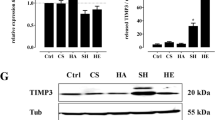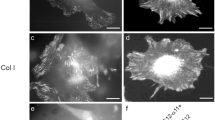Abstract
Asporin is an extracellular matrix (ECM) protein that regulates cartilage matrix gene expression and cartilage formation by modulating the transforming growth factor-β (TGF-β) signaling pathway. Our previous studies have indicated that asporin binds to TGF-β1 directly and inhibits TGF-β1-mediated expression of cartilage matrix genes. However, it is still unknown how asporin interacts with TGF-β1 and influences its activity. Using competition assays, we determined that amino acids 159–205 of asporin mediate its interaction with TGF-β1 and effectively repress TGF-β1-induced cartilage matrix gene expression. Asporin also has a binding ability to type II collagen in vitro, but its binding pattern is different from that of TGF-β1. In contrast with previous in vivo findings, asporin did not affect the interaction between TGF-β1 and the TGF-β type II receptor (TβRII) by itself or in the presence of type II collagen in vitro. However, in the presence of heparin/heparan sulfate, asporin inhibits the interaction between TGF-β and TβRII in vitro. These findings suggest that asporin is one of the important cartilage matrix proteins that binds to the ECM and TGF-β1 and thereby modulates interactions between TGF-β and its signaling receptors.






Similar content being viewed by others
References
Hocking AM, Shinomura T, McQuillan DJ (1998) Leucine-rich repeat glycoproteins of the extracellular matrix. Matrix Biol 17:1–19
Iozzo RV, Murdoch AD (1996) Proteoglycans of the extracellular environment: clues from the gene and protein side offer novel perspectives in molecular diversity and function. FASEB J 10:598–614
Ameye L, Young MF (2002) Mice deficient in small leucine-rich proteoglycans: novel in vivo models for osteoporosis, osteoarthritis, Ehlers–Danlos syndrome, muscular dystrophy, and corneal diseases. Glycobiology 12:107R–116R
Henry SP, Takanosu M, Boyd TC, Mayne PM, Eberspaecher H, Zhou W, de Crombrugghe B, Hook M, Mayne R (2001) Expression pattern and gene characterization of asporin. A newly discovered member of the leucine-rich repeat protein family. J Biol Chem 276:12212–12221
Lorenzo P, Aspberg A, Onnerfjord P, Bayliss MT, Neame PJ, Heinegard D (2001) Identification and characterization of asporin. A novel member of the leucine-rich repeat protein family closely related to decorin and biglycan. J Biol Chem 276:12201–12211
Scholzen T, Solursh M, Suzuki S, Reiter R, Morgan JL, Buchberg AM, Siracusa LD, Iozzo RV (1994) The murine decorin. Complete cDNA cloning, genomic organization, chromosomal assignment, and expression during organogenesis and tissue differentiation. J Biol Chem 269:28270–28281
Krusius T, Ruoslahti E (1986) Primary structure of an extracellular matrix proteoglycan core protein deduced from cloned cDNA. Proc Natl Acad Sci USA 83:7683–7687
Fisher LW, Termine JD, Young MF (1989) Deduced protein sequence of bone small proteoglycan I (biglycan) shows homology with proteoglycan II (decorin) and several nonconnective tissue proteins in a variety of species. J Biol Chem 264:4571–4576
Neame PJ, Choi HU, Rosenberg LC (1989) The primary structure of the core protein of the small, leucine-rich proteoglycan (PG I) from bovine articular cartilage. J Biol Chem 264:8653–8661
Kizawa H, Kou I, Iida A, Sudo A, Miyamoto Y, Fukuda A, Mabuchi A, Kotani A, Kawakami A, Yamamoto S, Uchida A, Nakamura K, Notoya K, Nakamura Y, Ikegawa S (2005) An aspartic acid repeat polymorphism in asporin inhibits chondrogenesis and increases susceptibility to osteoarthritis. Nat Genet 37:138–144
Hildebrand A, Romaris M, Rasmussen LM, Heinegard D, Twardzik DR, Border WA, Ruoslahti E (1994) Interaction of the small interstitial proteoglycans biglycan, decorin and fibromodulin with transforming growth factor beta. Biochem J 302(Pt 2):527–534
Yamaguchi Y, Mann DM, Ruoslahti E (1990) Negative regulation of transforming growth factor-beta by the proteoglycan decorin. Nature (Lond) 346:281–284
Andres JL, Stanley K, Cheifetz S, Massague J (1989) Membrane-anchored and soluble forms of betaglycan, a polymorphic proteoglycan that binds transforming growth factor-beta. J Cell Biol 109:3137–3145
Fukushima D, Butzow R, Hildebrand A, Ruoslahti E (1993) Localization of transforming growth factor beta binding site in betaglycan. Comparison with small extracellular matrix proteoglycans. J Biol Chem 268:22710–22715
Segarini PR, Seyedin SM (1988) The high molecular weight receptor to transforming growth factor-beta contains glycosaminoglycan chains. J Biol Chem 263:8366–8370
Nakajima M, Kizawa H, Saitoh M, Kou I, Miyazono K, Ikegawa S (2007) Mechanisms for asporin function and regulation in articular cartilage. J Biol Chem 282:32185–32192
Hedbom E, Heinegard D (1989) Interaction of a 59-kDa connective tissue matrix protein with collagen I and collagen II. J Biol Chem 264:6898–6905
Vogel KG, Paulsson M, Heinegard D (1984) Specific inhibition of type I and type II collagen fibrillogenesis by the small proteoglycan of tendon. Biochem J 223:587–597
Whinna HC, Choi HU, Rosenberg LC, Church FC (1993) Interaction of heparin cofactor II with biglycan and decorin. J Biol Chem 268:3920–3924
Brown DC, Vogel KG (1989) Characteristics of the in vitro interaction of a small proteoglycan (PG II) of bovine tendon with type I collagen. Matrix 9:468–478
Schonherr E, Hausser H, Beavan L, Kresse H (1995) Decorin-type I collagen interaction. Presence of separate core protein-binding domains. J Biol Chem 270:8877–8883
Schonherr E, Broszat M, Brandan E, Bruckner P, Kresse H (1998) Decorin core protein fragment Leu155–Val260 interacts with TGF-beta but does not compete for decorin binding to type I collagen. Arch Biochem Biophys 355:241–248
Massague J (1998) TGF-beta signal transduction. Annu Rev Biochem 67:753–791
Capila I, Linhardt RJ (2002) Heparin–protein interactions. Angew Chem Int Ed Engl 41:391–412
Weber IT, Harrison RW, Iozzo RV (1996) Model structure of decorin and implications for collagen fibrillogenesis. J Biol Chem 271:31767–31770
Scott PG, McEwan PA, Dodd CM, Bergmann EM, Bishop PN, Bella J (2004) Crystal structure of the dimeric protein core of decorin, the archetypal small leucine-rich repeat proteoglycan. Proc Natl Acad Sci USA 101:15633–15638
Rada JA, Cornuet PK, Hassell JR (1993) Regulation of corneal collagen fibrillogenesis in vitro by corneal proteoglycan (lumican and decorin) core proteins. Exp Eye Res 56:635–648
Acknowledgments
We thank Hideki Kizawa for help in the study and Tomomi Isono and Tomoko Kusadokoro for excellent technical assistance.
Author information
Authors and Affiliations
Corresponding author
About this article
Cite this article
Kou, I., Nakajima, M. & Ikegawa, S. Binding characteristics of the osteoarthritis-associated protein asporin. J Bone Miner Metab 28, 395–402 (2010). https://doi.org/10.1007/s00774-009-0145-8
Received:
Accepted:
Published:
Issue Date:
DOI: https://doi.org/10.1007/s00774-009-0145-8




